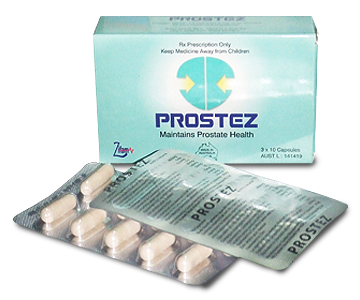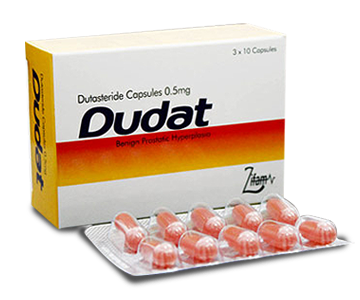Dudat – T
- ENG
- မြန်မာ
DUDAT – T
Tamsulosin Hydrochloride 0.4 mg and Dutasteride 0.5 mg Capsules
Each Hard Gelatin Capsule Contains:
| Tamsulosin Hydrochloride
(As Modified Release Pellets) |
0.4 mg |
| Dutasteride | 0.5 mg |
PHARMACOLOGICAL PROPERTIES:
PHARMACODYNAMICS:
Pharmacotherapeutic group: Alpha-adrenoreceptor antagonists.
ATC code: G04CA52
Dutasteride, a dual 5 α-reductase inhibitor (5 ARI) and Tamsulosin hydrochloride, an antagonist of α1a and α1d adrenoreceptors.
These drugs have complementary mechanisms of action that rapidly improve symptoms, urinary flow and reduce the risk of acute urinary retention (AUR) and the need for BPH related surgery.
Dutasteride inhibits both type 1 and type 2, 5 alpha-reductase isoenzymes, which are responsible for the conversion of testosterone to dihydrotestosterone (DHT).
DHT is the androgen primarily responsible for prostate growth and BPH development.
Tamsulosin inhibits αta and αtd adrenergic receptors in the stromal prostatic smooth muscle and bladder neck.
Approximately 75% of the α1-receptors in the prostate are of the α1a subtype.
PHARMACOKINETICS:
Absorption
Dutasteride:
Following oral administration of a single 0.5 mg dutasteride dose, the time to peak serum concentrations of dutasteride is 1 to 3 hours.
The absolute bioavailability is approximately 60%.
The bioavailability of dutasteride is not affected by food.
Tamsulosin:
Tamsulosin is absorbed from the intestine and is almost completely bioavailable.
Both the rate and extent of absorption of tamsulosin are reduced when taken within 30 minutes of a meal.
Tamsulosin shows dose proportional plasma exposure.
Distribution
Dutasteride:
Dutasteride has a large volume of distribution (300 to 500 L) and is highly bound to plasma proteins (>99.5%).
Following daily dosing, dutasteride serum concentrations achieve 65% of steady state concentration after 1 month and approximately 90% after 3 months.
Tamsulosin:
In man tamsulosin is about 99% bound to plasma proteins. The volume of distribution is small (about 0.21/kg).
Metabolism
Dutasteride:
Dutasteride is extensively metabolised in vivo.
In vitro, dutasteride is metabolised by the cytochrome P450 3A4 and 3A5 to three monohydroxylated metabolites and one dihydroxylated metabolite.
Following oral dosing of dutasteride 0.5 mg/day to steady state, 1.0% to 15.4% of the administered dose is excreted as unchanged dutasteride in the faeces.
The remainder is excreted in the faeces as 4 major metabolites comprising 39%, 21%, 7%, and 7% each of drug-related material and 6 minor metabolites.
Only trace amounts of unchanged dutasteride (< 0.1% of the dose) are detected in human urine.
Tamsulosin:
There is no enantiomeric bioconversion of tamsulosin hydrochloride in humans.
Tamsulosin hydrochloride is extensively metabolised by cytochrome P450 enzymes in the liver and less than 10% of the dose is excreted in urine unchanged.
However, the pharmacokinetic profile of the metabolites in humans has not been established.
The metabolites of tamsulosin hydrochloride undergo extensive conjugation to glucuronide or sulfate prior to renal excretion.
Elimination
Dutasteride:
The elimination of dutasteride is dose dependent.
At low serum concentrations (<3 ng/mL), dutasteride is cleared rapidly.
Single dose of 5 mg or less shows evidence of rapid clearance and a short half-life of 3 to 9 days.
At therapeutic concentrations, following repeat dosing of 0.5 mg/day, the slower, linear elimination pathway is dominating and the half-life is approx. 3-5 weeks.
Tamsulosin:
Tamsulosin and its metabolites are mainly excreted in the urine with about 9% of a dose being present in the form of unchanged active substance.
Following intravenous or oral administration of an immediate-release formulation, the elimination half life of tamsulosin in plasma range from 5 to 7 hours.
INDICATIONS:
– Treatment of moderate to severe symptoms of benign prostatic hyperplasia (BPH).
– Reduction in the risk of acute urinary retention (AUR) and surgery in patients with moderate to severe symptoms of BPH.
POSOLOGY AND METHOD OF ADMINISTRATION
Posology:
Adults (including elderly): One capsule daily
Renal impairment: No adjustment in dosage is anticipated for patients with renal impairment 60
Hepatic impairment: Caution should be used in patients with mild to moderate hepatic impairment. In patients with severe hepatic impairment, the use of DUDAT-T is contraindicated.
Method of administration: Taken orally approximately 30 minutes after the same meal each day
The capsules should be swallowed whole and not chewed or opened. Contact with the contents of the dutasteride capsule may result in irritation of the oropharyngeal mucosa.
CONTRAINDICATIONS:
DUDAT-T is contraindicated in:
women and children and adolescents.
– patients with hypersensitivity to dutasteride, other 5-alpha reductase inhibitors, tamsulosin (including tamsulosin- induced angio-edema), soya, peanut or any of other the excipients.
– patients with a history of orthostatic hypotension.
– patients with severe hepatic impairment.
WARNINGS AND PRECAUTIONS:
Prostate cancer and high grade tumours: Men taking Dutasteride and Tamsulosin combination should be regularly evaluated for prostate cancer risk including PSA (Prostate specific antigen) testing.
Renal impairment: The treatment of severely renally impaired patients (creatinine clearance of less than 10 ml/min) should be approached with caution as these patients have not been studied.
Hypotension: As with other alpha-blockers, a reduction in blood pressure can occur during treatment with tamsulosin, as a result of which, rarely, syncope can occur. Patients beginning treatment with this combination should be cautioned to sit or lie down at the first signs of orthostatic hypotension (dizziness, weakness) until the symptoms have resolved. In order to minimise the potential for developing postural hypotension the patient should be haemodynamically stable on alpha-blocker therapy prior to initiating use of PDE5 inhibitors.
Intraoperative Floppy Iris Syndrome: Intraoperative Floppy Iris Syndrome (IFIS, a variant of small pupil syndrome) has been observed during cataract surgery in some patients on or previously treated with tamsulosin. IFIS may lead to increased procedural complications during the operation. The initiation of therapy with Combodart in patients for whom cataract surgery is scheduled is therefore not recommended.
Leaking Capsule: Dutasteride is absorbed through the skin, therefore, women, children and adolescents must avoid contact with leaking capsules. If contact is made with leaking capsules, the contact area should be washed immediately with soap and water.
Inhibitors of CYP3A4 and CYP2D6: Concomitant administration of tamsulosin hydrochloride with strong inhibitors of CYP3A4 (e.g. ketoconazole), or with strong inhibitors of CYP2D6 (e.g. paroxetine) can increase tamsulosin exposure. Tamsulosin hydrochloride is therefore not recommended in patients taking a strong CYP3A4 inhibitor and should be used with caution in patients taking a strong (e.g. paroxetine) CYP2D6 inhibitor.
Tamsulosin hydrochloride should be used with caution in patients taking a moderate CYP3A4 inhibitor (e.g. erythromycin) in combination with either strong (e.g. paroxetine) or moderate (e.g. terbinafine) CYP2D6 inhibitors, or in patients known to be poor metabolisers of CYP2D6.
Hepatic impairment: Caution should be used in the administration of this combination to patients with mild to moderate hepatic impairment.
Breast neoplasia: Breast cancer has been reported in men taking dutasteride in clinical trials and during the post- marketing period.
INTERACTIONS:
Effects of other drugs on the pharmacokinetics of Dutasteride
Use together with CYP3A4 and/or P-glycoprotein-inhibitors: Dutasteride is mainly eliminated via metabolism. In vitro studies indicate that this metabolism is catalysed by CYP3A4 and CYP3A5. No formal interaction studies have been performed with potent CYP3A4 inhibitors.
Long-term combination of Dutasteride with drugs that are potent inhibitors of the enzyme CYP3A4 (e.g. ritonavir, indinavir, nefazodone, itraconazole, ketoconazole administered orally) may increase serum concentrations of Dutasteride.
Dutasteride has no effect on the pharmacokinetics of warfarin or digoxin. This indicates that Dutasteride does not inhibit/induce CYP2C9 or the transporter P-glycoprotein. In vitro interaction studies indicate that Dutasteride does not inhibit the enzymes CYP1A2, CYP2A6, CYP2E1, CYP2C8, CYP2D6, CYP2C9, CYP2C19, CYP2B6 or CYP3A4.
Tamsulosin: Concomitant administration of tamsulosin hydrochloride with drugs which can reduce blood pressure, including anaesthetic agents, PDE5 inhibitors and other alpha- 1 adrenergic blockers could lead to enhanced hypotensive effects. Dutasteride-tamsulosin should not be used in combination with other alpha-1 adrenergic blockers.
Concomitant administration of tamsulosin hydrochloride and ketoconazole resulted in an increase of the Cmax and AUC of tamsulosin hydrochloride. Concomitant administration of tamsulosin hydrochloride and paroxetine resulted in an increase of the Cmax and AUC of tamsulosin hydrochloride. Concomitant administration of tamsulosin hydrochloride (0.4 mg) and cimetidine (400 mg every six hours for six days) resulted in a decrease in the clearance (26%) and an increase in the AUC (44%) of tamsulosin hydrochloride. Caution should be used when dutasteride-tamsulosin is used in combination with cimetidine.
No interactions have been seen when tamsulosin hydrochloride was given concomitantly with either atenolol, enalapril, nifedipine or theophylline. Concomitant furosemide brings about a fall in plasma levels of tamsulosin, but as levels remain within the normal range posology need not be adjusted.
PREGNANCY AND LACTATION:
Dutasteride is contraindicated for use by women.
Pregnancy As with other 5 alpha reductase inhibitors, Dutasteride inhibits the conversion of testosterone to dihydrotestosterone and may, if administered to a woman carrying a male foetus, inhibit the development of the external genitalia of the foetus. Small amounts of Dutasteride have been recovered from the semen in subjects receiving Dutasteride. It is not known whether a male foetus may be adversely affected if his mother is exposed to the semen of a patient being treated with Dutasteride.
Administration of tamsulosin hydrochloride to pregnant female rats and rabbits showed no evidence of foetal harm.
Lactation: It is not known whether Dutasteride or Tamsulosin are excreted in human milk.
UNDESIRABLE EFFECTS:
Reproductive system and breast disorders: Impotence Altered (decreased) libido, Ejaculation disorders, and Breast disorders.
Nervous system disorders: Dizziness
General disorders and administration site disorders: Asthenia
PRESENTATION:
30 capsules
STORAGE:
Store below 30°C. Protect from light and moisture.








